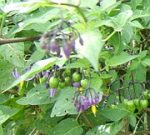 Also called bittersweet, poisonflower, and many other common names, this deciduous semi-woody perennial vine is a member of the potato family, Solonaceae, that also include peppers, tobacco, and petunia. The genus, Solanum, includes tomato and eggplant, but NOT deadly night shade (Atropa belladonna). Climbing nightshade is native to Africa, Europe, and Asia where in grows in damp woodlands, thickets, wasteplaces, scrubland, and marshes, but has naturalized all over the world including North America and has become invasive in some areas.
Also called bittersweet, poisonflower, and many other common names, this deciduous semi-woody perennial vine is a member of the potato family, Solonaceae, that also include peppers, tobacco, and petunia. The genus, Solanum, includes tomato and eggplant, but NOT deadly night shade (Atropa belladonna). Climbing nightshade is native to Africa, Europe, and Asia where in grows in damp woodlands, thickets, wasteplaces, scrubland, and marshes, but has naturalized all over the world including North America and has become invasive in some areas.
Growing up to ten feet in length from a taproot with rhizomes, climbing nightshade grows on the ground or climbs on other plants by twining with slender, smooth stems that are purple. The dark green leaves are 1 ½ to 8” long, oval to heart-shaped with pointed tips, and are often lobed at the base. The purple to bluish star-shaped flowers are produced throughout the summer in loose clusters and have five reflexed petals and bright yellow exerted stamens. The fruit is a small red egg-shaped berry attractive to and edible for birds but is poisonous for humans and livestock. The entire plant is poisonous and since it is not ornamentally attractive is best not planted in a garden or area where children or livestock could come in contact with it.
Type: Semi-woody perennial vine
Bloom: Loose clusters of purple to bluish star-shaped flowers with five reflexed petals and bright yellow exerted stamens; throughout the summer
Size: 2-10’ H
Light: Full sun to partial
Soil: Fertile, consistently moist, well-drained
Hardiness: Zones 3-10
Care: Remove unwanted seedlings as they can become weedy and be invasive.
Pests and Diseases: None of significance
Propagation: Seed, division
Photo Credit: Wikipedia, Big Waters, Northumberland